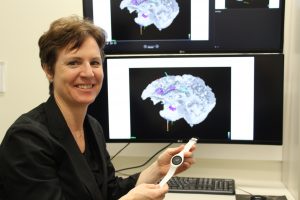Can you sum up the aim of this project in 10 words?
To investigate peripheral autonomic biomarkers linked to specific seizure types, including stress-triggered seizures.
What have you previously discovered in this area?
Stress is reported as the commonest trigger of seizures by people with epilepsy. Emotional brain circuits are often involved during seizures and may contribute to sensitivity to stress acting as a trigger for seizures, although the exact mechanisms are poorly understood. Previous work with depth recording (stereoelectroencephalography, SEEG) has helped elucidate the role of the brain’s limbic networks in epileptic seizures. Smartwatches allow the non-invasive monitoring of autonomic function (heart rate variability, electrodermal activity) that can be compared with EEG and SEEG data, in addition to detailed video analysis of seizure semiology and psychological profile. Machine learning algorithms will help elucidate patterns that will be grounded in clinician expertise and patient experience.
What aspect of this research excites you the most?
I am excited to use a multi-modal approach to better understand seizure profiles at the individual level, which could help refine personalised seizure detection and management. By looking at how brain signals relate to the activity measured on the device, and how both of these relate to psychological profile in epilepsy, we’re breaking new ground, so the potential of this is truly exciting. At Mater Research, we are constantly seeking to improve the life-long management across the spectrum of neurological diseases and conditions and are committed to finding the best possible care and outcomes for patients and our broader community. This project will hopefully contribute to this aim.

Prof Aileen McGonigal
Does predicting seizures translate into preventing seizures?
Currently, there are very limited means to predict or even to accurately detect seizures. Exciting research work in these domains is taking place in Australia and around the world, which could have a great impact on quality of life for people with epilepsy. We hope that what we’re doing at Mater Research and The University of Queensland will add to the growing body of knowledge in this important field. Our project could bring us a step closer to being able to refine seizure detection methods to detect a greater variety of seizure types, with better accuracy. It’s hoped the wearable technology will ultimately give people with epilepsy more control over their health, especially the third or so who still have seizures despite medication.
Where else in neurology does wearable technology have potential applications?
The use of smartwatch technology to record data has the potential to have a very wide application in neurological research. For instance, it could be used in assessing symptoms related to Parkinson’s disease, dementia, traumatic brain injury and stroke. Not only are there benefits in the real-time return of data and the personalised approach to health management, it’s also more widely accepted by patients and their families as these devices are non-invasive and non-stigmatising.
How long before your work might impact on patient care?